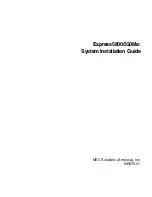
© Microhard
110
6.0 Installation
6.2 Installation of Antenna System Components
The installation, removal, or maintenance of any antenna system components must be under-
taken only by qualified and experienced personnel.
6.2.1 Antennas
The two most common types of antenna are the omnidirectional
(’
omni
’)
and directional (Yagi).
An
omni
typically has 3
-
6dBi gain and spreads its energy in all directions (hence the name
’
omnidirectional
’).
The
’
pattern
’
of the energy field is in the shape of a donut, with the antenna
mounted vertically at the centre. This vertical
-
mounted antenna produces a signal which is
vertically
’
polarized
’.
A
Yagi
has a more focused antenna pattern, which results in greater gain: commonly, 6
-
12dBi.
The pattern of a Yagi is in the shape of a large raindrop in the direction in which the antenna is
pointed. If the elements of the Yagi are perpendicular to the ground (most common orienta-
tion) the radiated signal will be vertically polarized; if parallel to the ground, the polarization is
horizontal.
The network topology, application, and path calculation are all taken into consideration when
selecting the various antenna types to be used in a radio network deployment.
Table 6
-
1: Path Loss
To
satisfy
FCC
radio
frequency (RF) exposure
requirements for mobile
transmitting
devices,
a
separation distance of 23cm
or
more
should
be
maintained between
the
antenna of this device and
persons
during
device
operation.
To
ensure
compliance, operation at
less than this distance is
not recommended. The
antenna
used
for
this
transmitter must not be co
-
located in conjunction with
any
other
antenna
or
transmitter.
Never work on an antenna
system
when
there
is
lightning in the area.
Distance (km)
Master Height (m)
Remote Height (m)
Path Loss (dB)
5
15
2.5
116.5
5
30
2.5
110.9
8
15
2.5
124.1
8
15
5
117.7
8
15
10
105
16
15
2.5
135.3
16
15
5
128.9
16
15
10
116.2
16
30
10
109.6
16
30
5
122.4
16
30
2.5
128.8
Summary of Contents for pMDDL5824
Page 23: ...Microhard 23 3 1 1 pMDDL5824 OEM Mechanical Drawing 3 0 Hardware Features...
Page 24: ...Microhard 24 3 1 2 pMDDL5824 PCB PAD Placement 3 0 Hardware Features...
Page 29: ...Microhard 29 3 0 Hardware Features 3 2 1 pMDDL5824 Development Board Mechanical Drawings...
Page 30: ...Microhard 30 3 0 Hardware Features 3 2 2 pMDDL5824 Enclosed Mechanical Drawings...
Page 114: ...Microhard 114 Appendix B Sample Interface Schematic...








































